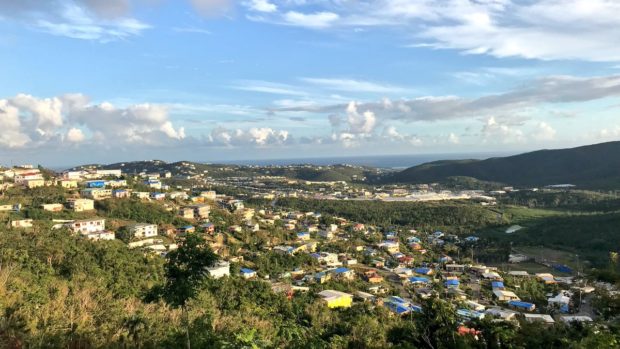We have much more to do and your continued support is needed now more than ever.
U.S. Virgin Islands Affiliate Sees Long Path to Recovery

During a visit to the U.S. Virgin Islands in January, 2018, National Wildlife Federation President and CEO Collin O’Mara saw evidence of the first steps toward recovery for people and wildlife, following the devastating hurricanes that struck the Caribbean in September 2017.
On Twitter and Facebook, O’Mara reported on closed schools and damaged housing stocks across the small island territory and he praised local recovery efforts, including those of the electric utility and Royal Caribbean cruise lines. Representing the Federation at the Friends of Virgin Islands National Park Annual Meeting on January 22, he described the continuing effects of natural disasters throughout the country, and urged the U.S. Congress to act on funding desperately needed to help rebuild communities in the U.S. Virgin Islands and Puerto Rico, and to restore habitat needed to defend against future storms, fires, and other catastrophic events.
Hurricane Irma made landfall in the U.S. Virgin Islands on September 6 as a category 5 storm–its sustained winds of 185 miles per hour were among the strongest ever recorded for an Atlantic hurricane. Throughout the 133-square mile territory (mainly composed of the islands of St. Thomas, St. John, and St. Croix, with a population of about 104,000), four people were killed, roofs were blown off buildings, windows were shattered, and nearly all the trees and shrubs were stripped of leaves and limbs. At the same time, wind and surging storm waters tore thousands of ships and boats from their moorings, dumping them into harbors, along beaches, and into sensitive mangrove lagoons. More was to come: Hurricane Maria struck the U.S. Virgin Islands on September 19. This time the damage came mostly from rains pouring into homes, hospitals, and businesses, where inhabitants were still reeling from the effects of Hurricane Irma. Amplified by the lost vegetation from Irma, there was extensive soil erosion and tons of mud and pollutants were washed into bays, harming mangroves, reef corals, and other aquatic life. In November, U.S. Virgin Islands Governor Kenneth E. Mapp requested $7 billion in disaster relief.

Hurricane Irma largely bypassed nearby Puerto Rico, but the damage Hurricane Maria caused to the more populous island is estimated to be between $45 billion and $95 billion.
In October, the National Wildlife Federation organized an emergency appeal to help the Federation’s affiliates, La Sociedad Ornitológica Puertorriqueña (SOPI) in Puerto Rico and the Virgin Islands Conservation Society (VICS), many of whose members sustained personal losses. Both organizations are currently using these funds for humanitarian aid, for community and habitat cleanup, and for surveying damage to wildlife populations and wildlife habitat.
By the start of 2018, overall recovery efforts in the U.S. Virgin Islands had succeeded in restoring power and clearing major roads, as well as removing most of the sunken boats and other debris from the main cruise ship harbor at Charlotte Amalie, the territory’s capital city. These efforts have helped to bring new life to the tourism-dependent local economy. Damage to the mangrove lagoons and coral reefs, which provide crucial storm protection, is known to be extensive but has not yet been fully surveyed. Members of VICS remain active in community cleanup, removing woody debris and mulching it for planting beds and recycling.

It is estimated that a full recovery could take up to two years for the U.S. Virgin Islands.
In the December-January issue of National Wildlife, Collin O’Mara wrote:
“The personal pain of natural disasters made 2017 a particularly tough year. But this pain reminds us that it has never been more important to be good at what we do—saving America’s wildlife together and making our natural resources more resilient. Thank you for standing with us.”
Speak out for legislation that supports natural infrastructure to better protect communities and wildlife during hurricanes and floods!




















